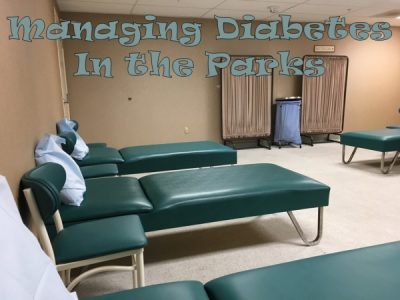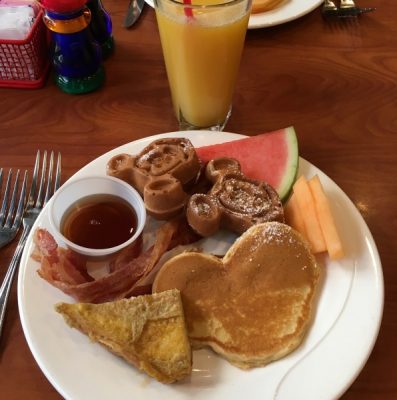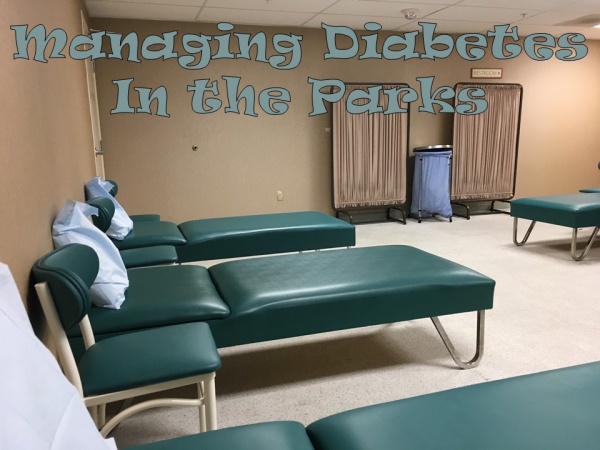
I have diabetes. There, I said it. When my GP said I had diabetes, it was both a relief and a dark dawning. I was about to head overseas to my favorite place—Disneyland. But how was I going to take part in my Disney holiday like normal when I was no longer ‘normal’? This blog is for those who have recently been diagnosed with diabetes or have a loved one who needs help managing diabetes in the Disney Parks. There is hope and Disney has medical pixie dust just for you.
Diabetes—Type 1 and Type 2
For this blog, I will skip the diabetic types and run the two together as insulin-dependent and non-insulin-dependent. Why? Management of diabetes is similar for non-insulin-dependent individuals. Likewise, those who take insulin have needs that are not different based on type of the disease.
For this blog post: non-insulin-dependent diabetics generally either manage their diabetes with diet, exercise, tablet medication, or a combination of these methods. Insulin-dependent diabetics are those people who may use the methods above but must also rely on injectable insulin to maintain their blood glucose levels.
It is important to note that I am not a medical doctor. I do not mean this blog post to replace the advice given by your medical professional team. I mean it to direct those with diabetes to the help that can be found at Disney Parks in the US.
Non-Insulin-Dependent Diabetes and the Disney Parks
Diet: Let’s face it, Disney embraces all those sweet, simple carbohydrate snacks we love to eat. Likewise, our favorite meals include high fat, fried food, often served with starchy root vegetables. Our dietitians would smack our hands for even thinking to indulge in such things.
It’s true that the diabetic at Disney needs to exercise some self-control. You can ask the food venders for the ingredient list for the food you would like to eat. Many will have the amount of carbohydrate/sugar listed on the pack. Some will only have a list of ingredients (this is particularly true for the meals at carts or counter service). Some things you would think of as ‘safe’ may not be the best option. For example: the turkey legs. These can have 35–60% carbohydrate because of their marinade. My family lovingly calls them candy coated turkey legs.
If you are planning on have a table service meal, ask for the diabetic/low carbohydrate menu (the ‘allergies’ menu). You can also ask to speak with the chief and discuss what you can and cannot eat. Disney table and counter service are happy to substitute other offered items for those you cannot eat (there may be a small surcharge, but I have never encountered it). So, when I order my hamburger at the Magic Kingdom, I will ask for a salad instead of chips, explaining that I cannot eat the starchy side.



Exercise: How often do our GP’s spruik the need to get our 10,000 steps each day. Generally, if you are walking in the parks and are there all day, you will get those 10,000 steps. Wear your step counters. You will watch those high numbers roll by and won’t feel quite so bad when you indulge in that Dole Whip (something I can no longer eat by myself as the sugar content is too high. But my husband is always happy to finish mine for me). If you are planning on a day off from the park, check out the pool or gym at your hotel. There are plenty of physical options to get that minimum of movement ticked off for the day.
Tablet Medication: Obviously, this is not a problem to bring along with you. I have a small kit I slip into my backpack which contains my glucometer and my medication. Bring your medication, glucometer, etc. with you on any attractions or into any shows. Do not leave it in a stroller outside. The reason for this is twofold. It is possible for items left in strollers to go missing at the parks. You definitely do not want this to happen to your medication/glucometer. It is also common for strollers to be moved around. On a hot day, they will often end up in the sun. It is possible for your medications to sit in the heat and this can decrease their effectiveness for you when taken.
Insulin-Dependent Diabetes and the Disney Parks
The above holds true for all diabetics. But those of us who rely on insulin have a few other issues.
Cartridge Insulin: Most insulin in cartridges can be stored at room temperature and should not be refrigerated. You will be familiar with the methods of transport of your specific type of cartridge and may wish to carry it in an insulated bag during the warmer months at Disney Parks.
Vial/Bottle Insulin: If you use insulin in a vial and you will need the insulin during your day, you will need to bring it in an insulated bag. Leave extra vials in your hotel room’s refrigerator. Make sure that your prescription is in your bag and that the bag is identified with your name, home address, and your hotel and room number. This way, if it goes missing, you might retrieve it. But also, you may store it in the first aid station at the parks. I don’t use vial insulin, so I have never needed to store it when at the parks, however, I have been told that the first aid centers will store your insulin for you in their refrigerator. When I have asked about this at the first aid centers, I have had a hit or miss depending on the cast member on the desk.
Injections and the Parks: Some diabetics are comfortable checking their blood glucose levels and adjusting their insulin levels at a table or on a bench in the parks. I am not one of those. Of course, there are ample toilets around the parks where you can sit in a stall, but I have issues with doing this medical procedure in the toilet. Happily, the first aid centers are helpful here. Walk in and explain that you need to check your blood glucose and just need a quiet place to do so. The cast member will happily show you to a room where you can do so in clean, cool, quiet.
Emergency Sugar: Bring those normal sugar snacks you have at home to help in case of low blood glucose. You will walk a lot at the park and it is deceptive. You might find that you have low blood glucose and will need a jellybean or two.
What if something goes wrong?
My first Disney visit with diabetes, I was concerned that something could go wrong. What if my daughter and I were alone, and I had a hypoglycemic episode? I worried for nothing. Disney has a long history of helping people with life-threatening illness enjoy their time with their families in the parks. If you have a diabetic episode, ask the nearest Cast Member to contact first aid for you, explaining the issues you are having. The professional medical staff will come to you and assist as needed.
Thanks to Disney Parks’ First Aid Cast Members and their policies on helping people manage illness in the park, your diabetic diagnosis will not hinder your holiday. Go, enjoy, spread the pixie dust.
What tips do you have for managing diabetes while visiting the Disney theme parks? Share them in the comments, or on Facebook or Twitter!
Did you like this article? Make sure to share it with your friends! Check below for easy ways to share!
Want to visit a Disney Destination? Contact The Magic for Less Travel for more information and a free, no-obligation quote.
Incoming search terms:
- https://www themouseforless com/blog_world/managing-diabetes-in-the-disney-parks/
- type 2 diabetes disneyland
- https://www themouseforless com/blog_world/managing-diabetes-in-the-disney-parks/#:~:text=Thanks to Disney Parks First visiting the Disney theme parks?
- First aid disneyland
- eating at disneyland with type 1 diabetes
- disney world with type 2 diabetes
- disney world diabetes food
- disney with diabetes
- disney for diabetics
- disney food for diabetics


